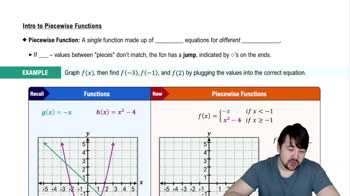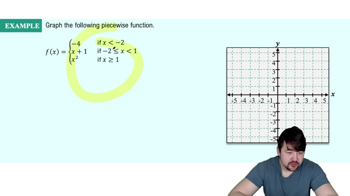Table of contents
- 0. Functions7h 52m
- Introduction to Functions16m
- Piecewise Functions10m
- Properties of Functions9m
- Common Functions1h 8m
- Transformations5m
- Combining Functions27m
- Exponent rules32m
- Exponential Functions28m
- Logarithmic Functions24m
- Properties of Logarithms34m
- Exponential & Logarithmic Equations35m
- Introduction to Trigonometric Functions38m
- Graphs of Trigonometric Functions44m
- Trigonometric Identities47m
- Inverse Trigonometric Functions48m
- 1. Limits and Continuity2h 2m
- 2. Intro to Derivatives1h 33m
- 3. Techniques of Differentiation3h 18m
- 4. Applications of Derivatives2h 38m
- 5. Graphical Applications of Derivatives6h 2m
- 6. Derivatives of Inverse, Exponential, & Logarithmic Functions2h 37m
- 7. Antiderivatives & Indefinite Integrals1h 26m
0. Functions
Piecewise Functions
Problem 30
Textbook Question
Graphing functions Sketch a graph of each function.
ƒ(x) = { 2x if x ≤ 1 , 3-x if x > 1
 Verified step by step guidance
Verified step by step guidance1
Identify the type of function: This is a piecewise function, which means it is defined by different expressions depending on the value of x.
Determine the domain for each piece: The function is defined as f(x) = 2x for x ≤ 1 and f(x) = 3 - x for x > 1.
Sketch the first piece: For f(x) = 2x when x ≤ 1, this is a linear function with a slope of 2. Plot the line starting from x = -∞ to x = 1, including the point (1, 2) as a solid dot since x = 1 is included.
Sketch the second piece: For f(x) = 3 - x when x > 1, this is also a linear function with a slope of -1. Plot the line starting just after x = 1, with an open circle at (1, 2) since x = 1 is not included in this piece, and continue to x = ∞.
Combine the pieces: Ensure the graph is continuous at x = 1 by checking the values of both pieces at this point. The first piece ends at (1, 2) and the second piece starts just after (1, 2), so the graph is not continuous at x = 1.
Recommended similar problem, with video answer:
 Verified Solution
Verified SolutionThis video solution was recommended by our tutors as helpful for the problem above
Video duration:
6mPlay a video:
Was this helpful?
Related Videos
Related Practice





